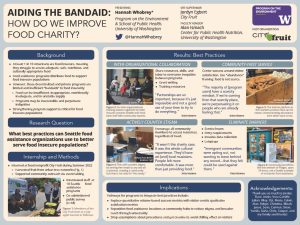Aiding the Bandaid: How do we Improve Food Charity?
At least 1 in 10 Americans struggle to access safe and nutritious food, known as food insecurity. Food assistance programs distribute food to support populations experiencing decreased access. However, these programs are primarily private and decentralized, leading to inefficiencies and limitations in addressing food access. Private programs often do not have enough food, offer limited choices, and suffer from instability and inaccessibility, causing indignities for program guests. Improving the support provided by these programs is critical in order to expand food access and reduce negative impacts, such as inadequate nutrition, on food insecure populations. The purpose of this study is to identify best practices for Seattle-area food assistance programs, in order to better serve food insecure populations. While interning at Seattle-based food assistance organization City Fruit, where I supported fruit harvesting and community outreach, I collected data through interviews with staff at 10 local programs and a public survey. Through these experiences, I gathered recommendations on how programs can better serve food insecure people. Key practices for cohesive, equitable care included eliminating barriers; prioritizing programs’ host and target communities; actively countering stigma; and increasing interorganization collaboration. These small scale changes to the frontlines of food assistance would make a rapid and tangible difference to food insecure populations, providing better support and mitigating harm on the ground while work continues toward systemic change addressing hunger’s root causes.
